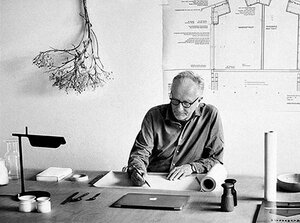[日本語]
この度、駐日デンマーク大使館が主催した展示会「Enriched Simplicity」について、デンマーク出身の建築家であるクリストファー・ハーラン氏の想いを聞きました。
1.デンマークの建築家が日本に興味を持ち始めたのはいつ頃からですか?
最初にデンマークの建築家の心に日本の影響が届いてから現在に至るまで日本からインスピレーションを得てきましたが、中でも1950年代ほど日本から強く影響を受けたことはありませんでした。そして興味深いことに、近年またその影響がとても強くなっています。今日、活躍しているデンマークの建築家とデザイナーは、新たなインスピレーションを求めて日本に目を向けています。
2.展覧会には、エリック・クリスチャン・ソレンセン(Erik Christian Sørensen)と彼自身の家が含まれています。作品を観る中で多くの人が日本の影響からの影響を否定できないと感じると思いいますが、彼自身は日本からではなくデンマークの農家から影響を受けたと述べています。展示会にどのような作品を含めるか、どのように決定しましたか?また、展示された建築家やデザイナーが実際に日本に触発されたことをどのように確かめることができますか?
そうですね、エリック・クリスチャン・ソレンセンがそのように述べたことは事実ですが、彼の家は間違いなく日本からの影響を受けたものだと思います。とても明らかなことです。ソレンセンは時々歴史家をからかうのを楽しんでいました。彼は日本に行ったことはありませんでしたが、日本の建築文化をよく知っていました。また、1960年代初頭にコペンハーゲンで出会った丹下健三氏についてもよく知っていました。彼は丹下氏のことが好きですし、彼の建物を賞賛しました。
3.歴史的にデンマークの建築家に特に影響を与えてきたのは、日本のどの建物や建築家ですか?
丹下健三はとても重要なインスピレーションの源だったと思います。例えば、東京湾の新都市の提案や1953年に建てた彼自身の家、またコンクリートの公共建築物などの作品です。
4.展覧会では、シドニー・オペラハウスで有名なヨーン・ウツソンが設計したコペンハーゲン郊外の別荘と桂離宮との驚くべきつながりを紹介します。彼が実際に日本への旅行で桂離宮を訪れたかどうか知っていますか?
ウツソンは、戦争中にストックホルムで数年間過ごしていた若いデンマーク人建築家のグループの1人です。彼らが訪れた場所の中の1つに民族学博物館の日本茶館があります。また、ウツソンは日本に幾つかの作品を残しているアメリカ人建築家フランク・ロイド・ライトの言葉や概念に影響を受けています。
5.今日、デンマークの建築家にとって最も興味深い日本の建築家はどのような方たちですか?
SANAA、隈研吾、Bow Wowスタジオの活動に大きな関心があると思いますが、名前を挙げるとすれば様々な年代の日本の建築家で構成されると思います。
6.陶磁器、家具、デザイン、建築など、日本の影響が最も顕著だった分野はどれだと思いますか?
陶磁器は明らかに影響を受けたと思いますし、製品のデザインや建物も影響を及ぼしたと思いますが、家具はそれほど多くありません。
7.あなたご自身はどうですか?特に影響を受けている建築家はどのような方たちでしょうか?
私は、Hammershusビジターセンターのコンテストを行ったときに学生達と一緒に日本に旅行しました。その旅行の際に受けた影響なしには、あの建物を作ることはできなかったと思います。
8.デンマークの城「Hammershus」にある、あなたの作品でもあるビジターセンターは今回の展示会の中でも展示されてります。このプロジェクトにはどのような日本の影響があった言えますか?
Bow WowによるCrane Houseから重要なインスピレーションを受けました。伝統的な建物と現代的な建物の組み合わせに強く感銘を受けました。特に、日本の建築家が独自の伝統を発展させ続けていることにワクワクしまし、とても刺激的を受けました!
クリストファー・ハーラン氏プロフィール:コペンハーゲンのRoyal Academy of Fine Arts, School of Architecture(デンマーク王立美術アカデミー、建築学校)の建築学の教授で、文化遺産・トランスフォーメーション・修復に関する研究所を率いています。 また北欧モダニズム建築についての専門家でもあり、自身のデザインスタジオを始めるまでは、エリック・クリスチャン・ソレンセンやヘニング・ラーセン等デンマークでも有数の建築家とも仕事をしてきました。彼は、建築設計事務所Arkitemaと共に取り組んだHammershus Visitors’ Centre (ハマースフス ビジターセンター)のプロジェクトでミースファンデルローエ賞にノミネートされ、またSkagerakやLouis Poulsenなどのブランドのプロダクトデザインにも取り組んでいます。
[English]
Danish architect Christoffer Harlang sharing his intentions behind the “Enriched Simplicity” exhibition he designed and curated for the Embassy of Denmark in Tokyo.
- When did Danish architects start to become interested in Japan?
There has been an inspiration from Japan since the first impressions made its way to the minds of Danish architects, but never with such an enormous impact as in the 1950’s. The interesting thing, I find, is that the inspiration has become very strong in recent years. Today the best contemporary Danish Architects and Designers look to Japan to find inspiration.
2. In the exhibition, you include Erik Christian Sørensen and his own house but while many find the Japanese influence undeniable, he himself has stated that he was not inspired by Japan but by Danish farmhouses. How did you decide on what to include in the exhibition – and how can you be sure the exhibited architects and designers were in fact inspired by Japan?
Well – Yes, it is very true that Erik Christian Sørensen made a point about this, but I think his house is without any doubt inspired by Japan. It is very evident. Sørensen sometimes enjoyed teasing historians a bit. He never went to Japan but he knew Japanese building culture quite well, of course, he did, and he was also very aware of Kenzo Tange who came to Copenhagen in the early 1960’s where the two of them met. He liked Tange and he admired his buildings.
3. Which buildings and architects in Japan have historically been most inspiring to Danish architects?
I think Kenzo Tange was a very important source of inspiration. From his proposal for a new city in Tokyo Bay, his own house from 1953 and his later works for example public buildings in concrete.
4. In the exhibition you show the remarkable connection between Katsura Rikyu and a villa outside Copenhagen designed by Jørn Utzon, famous for the Sydney Opera. Do you know if he actually visited Katsura Rikyu on his travels to Japan?
Utzon was among the group of young Danish Architects who spend a couple of years in Stockholm during the war and one of the sites they visited was a Japanese tea pavilion at the Ethnographic Museum. Utzon was also a follower of the American architect Frank Lloyd Wright who built in Tokyo and became influenced by the words and concepts of Wright.
5. Which Japanese architects are most interesting to Danish architects today?
I think there is a great interest in what SANAA, Kengo Kuma, Bow Wow studio does but the list is long and comprises several generations of Japanese Architects.
6. Within which field do you think the Japanese influence has been most prominent – ceramics, furniture, design or architecture?
I think ceramics is obvious, and also product design and buildings – not so much furniture though.
7. How about yourself? Which architects are you especially influenced by?Your own visitors’ centre at the Danish castle Hammershus is part of the exhibition. In what way would say there has been a Japanese influence on that project?
When we did the competition for Hammershus Visitors centre, I had just been on a trip with my students to Japan and I could not have made Hammershus Visitors’ Centre, had I not been influenced on that trip.
8. Your own visitors’ centre at the Danish castle Hammershus is part of the exhibition. In what way would say there has been a Japanese influence on that project?
Crane House by BowWow was an important inspiration. I was completely blown away by what I saw, from traditional buildings and contemporary both and I was especially excited by how the Japanese architects keep developing their own tradition. It is very inspiring to see that!
Profile: Christoffer Harlang is professor in architecture at the Royal Academy of Fine Arts School of Architecture in Copenhagen. Here, he heads the Institute of Cultural Heritage, Transformation and Restoration. He is an expert in Nordic modernism and has worked for several of the most important Danish architects, incl. Erik Christian Sørensen and Henning Larsen, before starting his own design studio. He was nominated for the Mies van der Rohe Award for his Hammershus Visitors’ Centre that he did with Arkitema and has carried out product design for Skagerak and Louis Poulsen among others.
